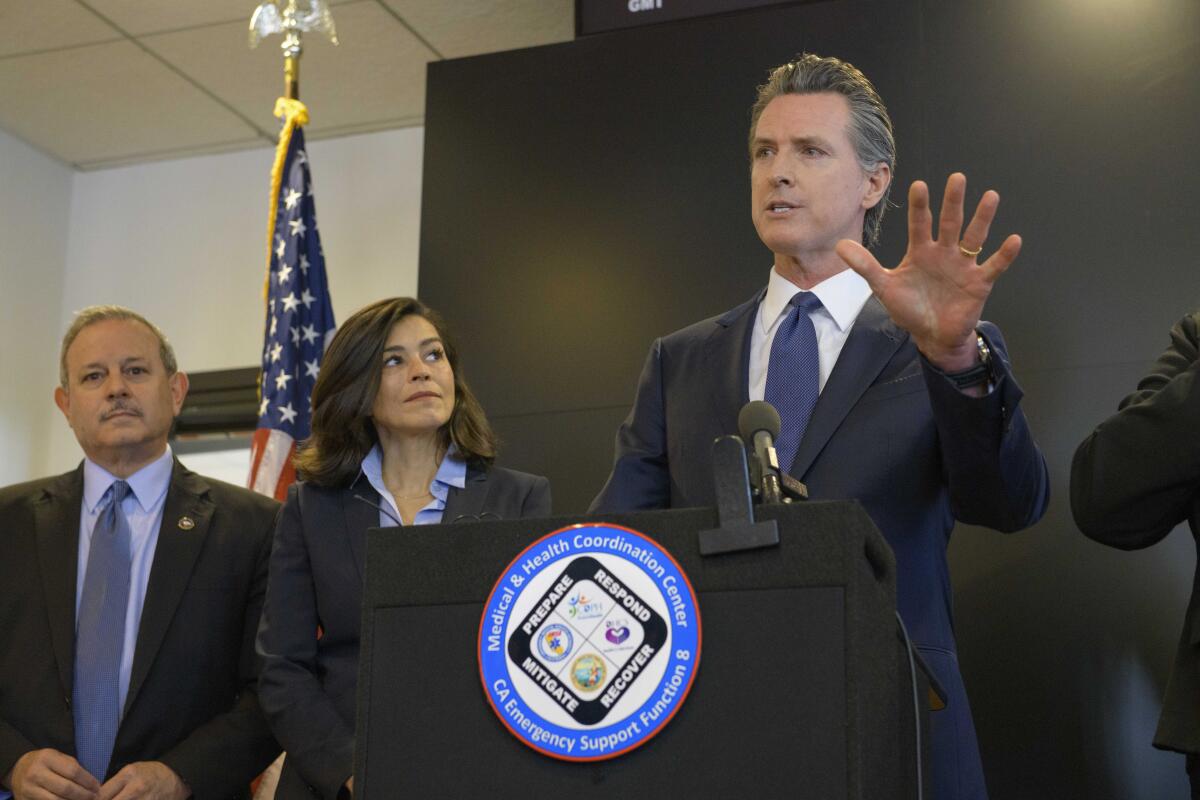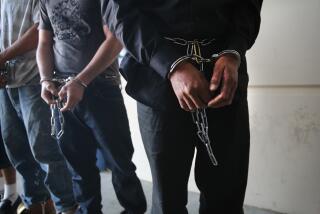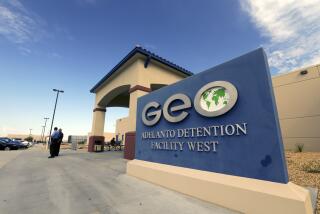ACLU sues California to block ICE transfers, reduce prison population amid coronavirus outbreak

- Share via
The American Civil Liberties Union filed a pair of lawsuits late Friday calling for a dramatic reduction in California’s incarcerated population and a halt to all transfers of inmates to federal immigration detention centers amid increasing signs throughout the U.S. that jails and prisons are hot zones for the spread of the coronavirus.
The suits filed with the California Supreme Court name Gov. Gavin Newsom and Atty. Gen. Xavier Becerra and come as the Otay Mesa Detention Center in San Diego and Lompoc penitentiary in Santa Barbara County have become home to some of the worst outbreaks in the federal prison system. In the lawsuits, the ACLU argued that outbreaks behind bars pose threats not only to the incarcerated, but also the families of jail and prison employees.
“It is not just those confined to jails, detention centers, and youth facilities who are in danger,” Peter J. Eliasberg, chief counsel of the ACLU in Southern California, said in a statement. “Once the virus gets inside, the regular movement of staff and visitors in and out means that walls and razor wire can neither slow nor stop the viral spread to communities at large.”
The suits argue that social distancing is almost impossible in immigration detention centers and California jails and prisons, where many house inmates in close proximity, with showers and meal areas that are communal.
A spokeswoman for the U.S. Department of Immigration and Customs Enforcement said the agency does not comment on pending litigation. The California Attorney General’s office referred question to Newsom.
“This Administration has been clear on our stance against abuses in immigration detention centers,” said Newsom’s press secretary, Vicky Waters. “We call on the Department of Homeland Security to use the administrative discretion it has under federal law to work with public health authorities to implement appropriate actions to protect individuals in its custody, staff and local communities.”
Waters did not immediately respond to questions about conditions in state prisons and jails.
ICE has reported 317 coronavirus infections among detainees nationwide, including 57 detainees at the Otay Mesa Detention Center in San Diego, according to its website.
In immigration facilities like Otay Mesa, the ACLU alleged guards were withholding personal protective equipment from detainees unless they signed waivers releasing the facility from liability. Detainees at Otay Mesa have also staged hunger strikes to protest conditions.
At the Adelanto facility north of Los Angeles, the ACLU contend staff have been reluctant to provide medical assistance to detainees and alleged one woman fell so ill from symptoms associated with the coronavirus that she lost consciousness before receiving aid. A federal judge has already ordered the population of the Adelanto facility to be reduced after a separate legal challenge by the ACLU.
Transfers from California prisons and jails now represent the “primary source of ICE’s new bookings” in the state, according to the suit, which argues that federal and state law do not obligate transfers to ICE. California’s sanctuary state law severely limits the number of detainees who can be turned over to ICE from California jails and prisons.
“In other words, it is the actions of the State of California, more than actions of ICE at this unique moment, that are keeping a flow of new people into ICE detention facilities,” the suit alleged.
Pointing to the significant number of coronavirus cases reported at New York City’s Rikers Island and the Cook County jail in Chicago as signs of how fast the illness could spread among California’s incarcerated population, the suit also called for a “drastic” reduction in the number of people held in state prisons and county jails.
“While the California Judicial Council has made some progress to reduce jail populations, these steps simply have not been large enough or fast enough to reduce the looming threat of exponential spread of COVID-19 in the state’s jails, juvenile facilities, and surrounding communities,” the suit read. “Leading public health officials have warned that without swift and large judicial intervention, the “epicenter of the pandemic will be jails and prisons.”
The Judicial Council ordered bail be set at zero for a wide array of misdemeanors and nonviolent crimes earlier this month, aiming to cut back on the number of new additions made to the state jail population. Newsom also sought the release of at least 3,500 state prison inmates with fewer than 60 days left on their sentence, and thousands of people have been released from Los Angeles County’s sprawling jail system.
Data show the state’s average daily incarcerated population fell from about 72,400 in late February to nearly 54,500 in early April, while bookings statewide have also plummeted. The number of juveniles in custody in California has also dropped by about 1,000 youths in that time frame, records show.
But the ACLU argued that reduction is not enough to allow for social distancing in most facilities, highlighting claims from the parents of several juveniles who say their kids are still sleeping in close proximity and not being given access to masks or sanitizer. A number of juvenile justice advocates have separately called on the California Supreme Court to intervene on behalf of youths in custody in L.A. County, where a number of judges have blocked petitions for early release that even had the support of local probation officers.
“A sizable enough reduction in the overall number of individuals in detention facilities allows social distancing for all inside, and facilitates both proper screening to prevent COVID[-19] from being introduced into the jails and proper isolation and monitoring of individuals who may be infected,” the suit read.
A number of law enforcement officials have raised alarm at the releases that have already taken place statewide. Orange County Dist. Atty. Todd Spitzer has argued that dangerous criminals, including a man suspected of sexually assaulting a child, have tried to capitalize on the pandemic to get out of custody.
“The Judicial Council’s decision to enact zero bail for most misdemeanors and numerous felonies allows dangerous criminals, including human traffickers, drivers who kill someone in a hit and run, and abusers of children and the elderly, to be released back into our neighborhoods,” Spitzer said in a statement addressing the zero-bail order earlier this month.
San Bernardino County Dist. Atty. Jason Anderson has argued the reduction efforts are confronting a problem that has yet to come to pass, and contended “many inmates in jail and prison environments have better access to medical care than when they are out of custody and in the community.”
More to Read
Sign up for Essential California
The most important California stories and recommendations in your inbox every morning.
You may occasionally receive promotional content from the Los Angeles Times.











